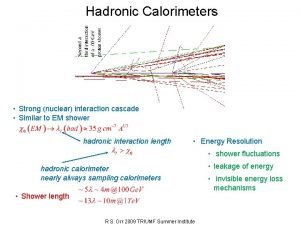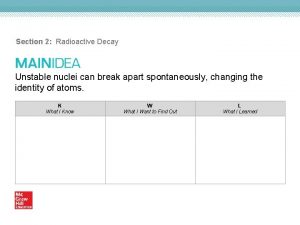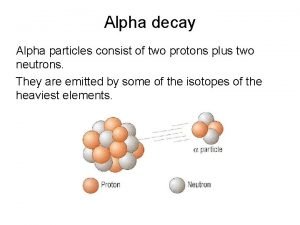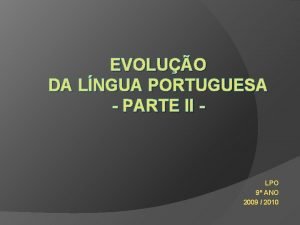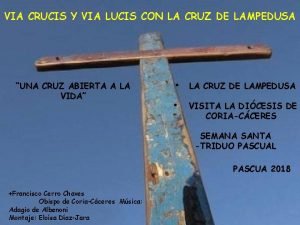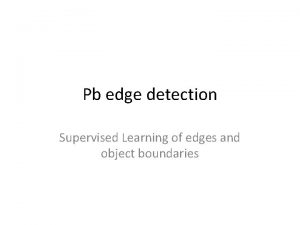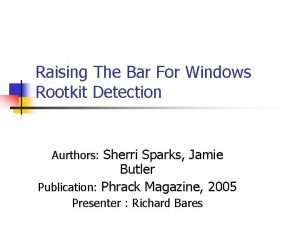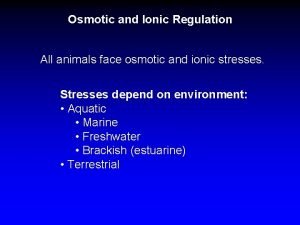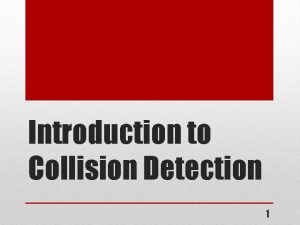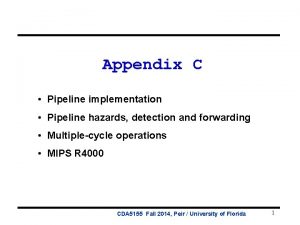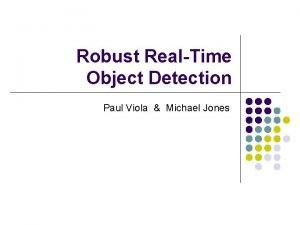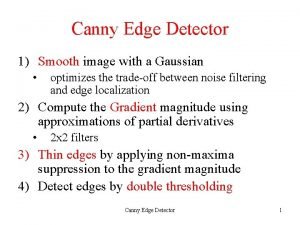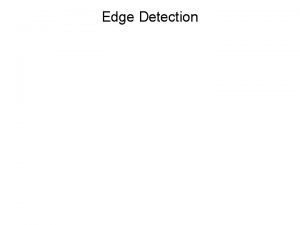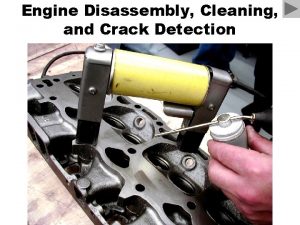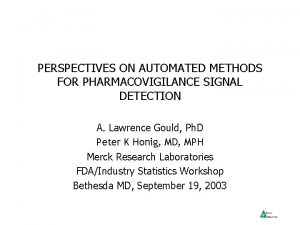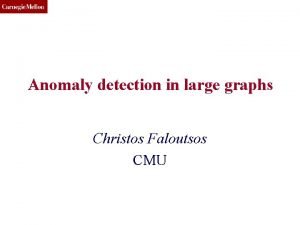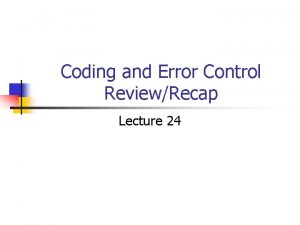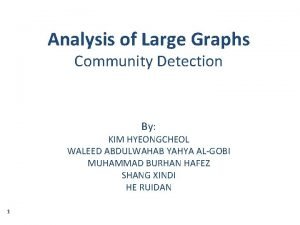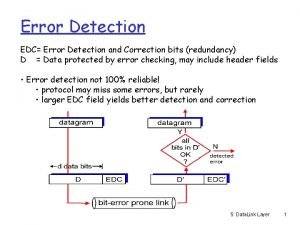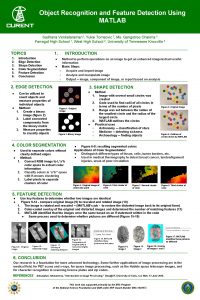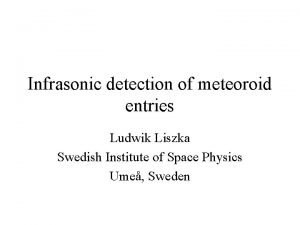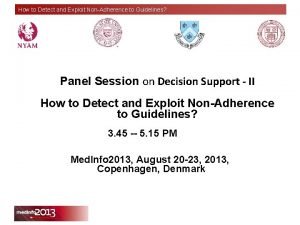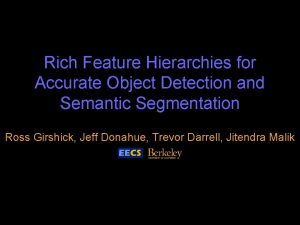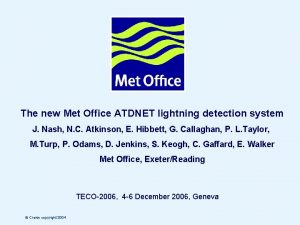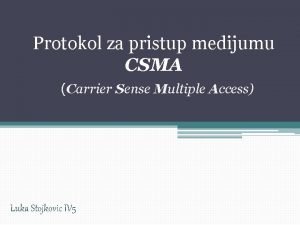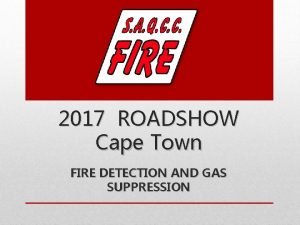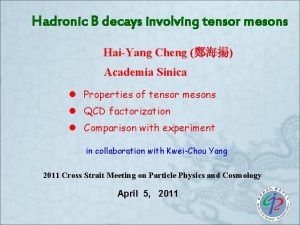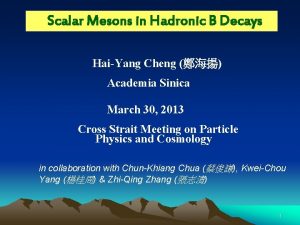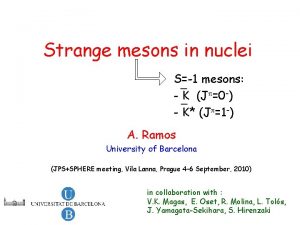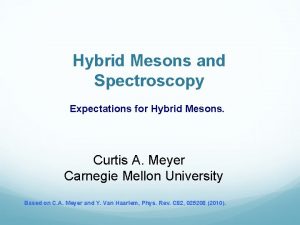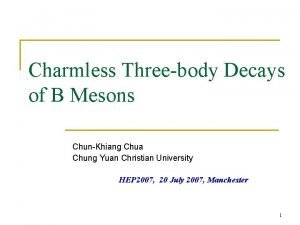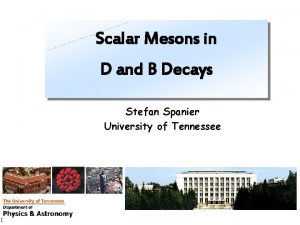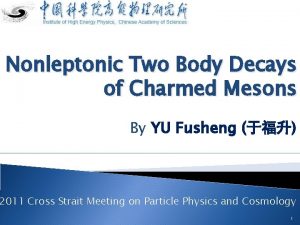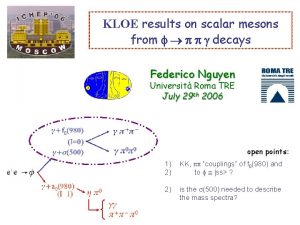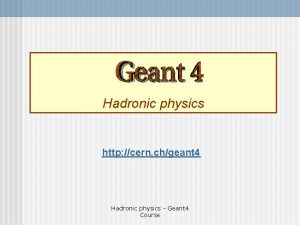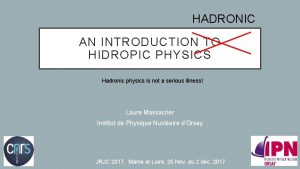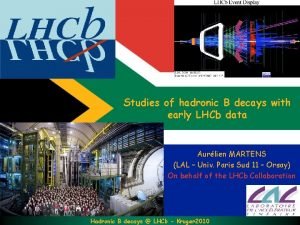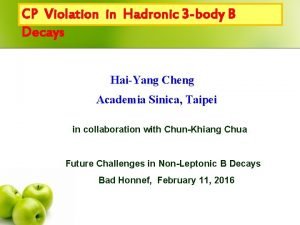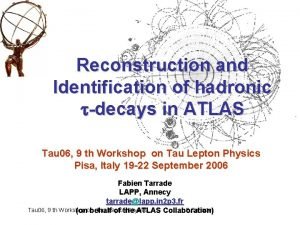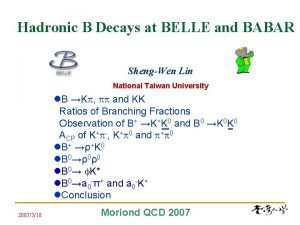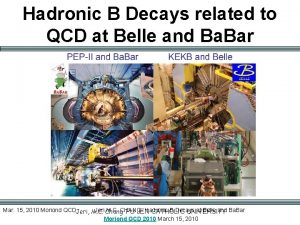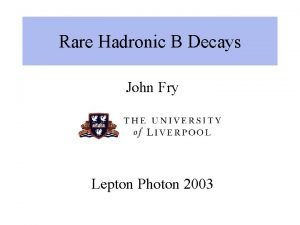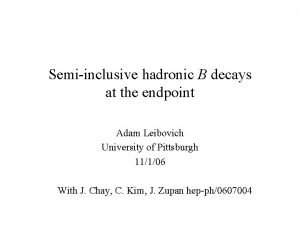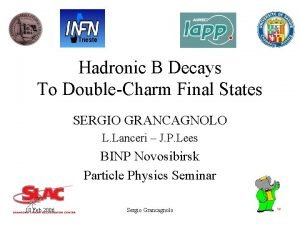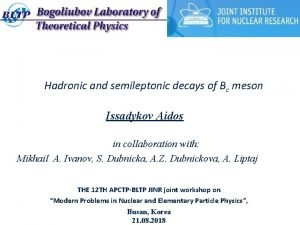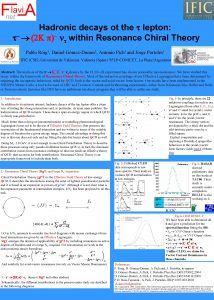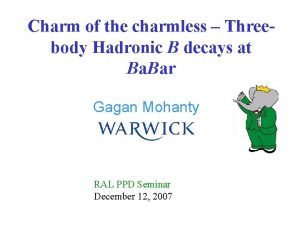0 D Detection of mesons via hadronic decays












































- Slides: 44

0 D Detection of mesons via hadronic decays in Pb-Pb collisions Andrea Dainese University of Padova TRD/TPC meeting, Heidelberg - November 13, 2002 Andrea Dainese 1

Table of questions What do we know about open charm in heavy ion collisions? Present experimental picture Why open charm in Pb-Pb at LHC? Physics motivation What do we look for? Topology of D 0 K- p+ decay How with ALICE? Detection strategy with ITS+TPC+TOF Which tools are needed for the feasibility study? Parameterization of TPC tracking How are signal and background simulated? How is the charm signal selected? What are the results? TRD/TPC meeting, Heidelberg - November 13, 2002 Andrea Dainese 2

Open charm data in heavy ion collisions Charm enhancement in Pb-Pb at SPS? NA 50: enhancement of dimuons in intermediate mass region Explained if assume a charm enhancement by 3. 5 over simple scaling with Ncoll NA 50 @ SPS s. NN = 17 Ge. V PHENIX @ RHIC s. NN = 130 Ge. V First results from RHIC (QM 2002) PHENIX: single-electron spectrum consistent with semi-electronic decays of D mesons (after subtraction of other e sources) Well reproduced by Pythia Ncoll Seems to exclude such a large enhancement TRD/TPC meeting, Heidelberg - November 13, 2002 Andrea Dainese 3

Charm in Pb-Pb at LHC C Pb Pb C C C time Charm quarks produced in initial hard scattering processes In a high-density partonic medium: energy loss of c quarks due in-medium gluon emissions ? additional production of cc pairs from secondary parton scattering ? Open charm is the natural normalization for J/ studies at LHC TRD/TPC meeting, Heidelberg - November 13, 2002 Andrea Dainese 4

ALICE: go for charm at LHC In order to probe: Essential to measure: Ø additional cc production Ø total cc production cross-section Ø energy loss of c quarks Ø p. T distribution of charm particles The observables have to be measured also in: Ø pp (for comparison) Ø p-A (disentangle "QGP effects" from nuclear effects - e. g. shadowing) D 0 K decay: Allows exclusive reconstruction of charm mesons ( semileptonic) direct measurement of charm p. T distribution TRD/TPC meeting, Heidelberg - November 13, 2002 Andrea Dainese 5

Detection strategy for D 0 K- + Weak decay with mean proper length ct = 124 mm Impact Parameter (distance of closest approach of a track to the primary vertex) of the decay products d 0 ~ 100 mm STRATEGY: invariant mass analysis of fully-reconstructed topologies originating from (displaced) secondary vertices Measurement of Impact Parameters Measurement of Momenta Particle identification to tag the two decay products TRD/TPC meeting, Heidelberg - November 13, 2002 Andrea Dainese 6

Detection strategy with ALICE Time Projection Chamber Track finding & Measurement of Momenta Magnetic field (B = 0. 4 Tesla in this study) Inner Tracking System Track finding, Measurement of the Momenta & Measurement of Impact Parameters TRD/TPC meeting, Heidelberg - November 13, 2002 Time Of Flight Particle Identification (K/p separation) Andrea Dainese 7

Particle Identification with TOF Why need PID? Background tracks are mostly pions Rejection of (p, p) pairs is very helpful PID with TOF mass of the particles is estimated from their time of flight particles are tagged according to graphical cuts in the p VS mass plot TOF PID strategy in TOF TDR: tag: KAON tag: PROTON all other particles (also not matched with a TOF hit) tag: PION Problem: too many kaons tagged as pions loss of the D 0 TRD/TPC meeting, Heidelberg - November 13, 2002 Andrea Dainese 8

TOF tagging probabilities Tag definition is not universal, it depends on the physics case Requirements for hadronic charm: high probability to tag correctly the kaons low probability to tag kaons as pions ( loss of the D 0) We introduced “non-id” for tracks not matched with a TOF hit Still, 28 % of the D 0 are lost because the kaon is tagged as a pion TRD/TPC meeting, Heidelberg - November 13, 2002 Andrea Dainese 9

Tuning of TOF PID strategy Introduce a graphical cut also for the pions tag: PION tag: KAON tag: PROTON others, tag: non-id Loss of signal reduced to 10% TRD/TPC meeting, Heidelberg - November 13, 2002 Andrea Dainese 10

Track reconstruction in TPC-ITS: d 0 measurement Measurement of impact parameters is crucial for secondary vertex reconstruction TRD/TPC meeting, Heidelberg - November 13, 2002 Andrea Dainese 11

Understanding d 0 resolution Better to understand numbers given by the simulation Saturation value of resolution at high p. T can be easily cross-checked at high p. T multiple scattering goes to 0 only the contribution of the measurement resolution is left: (r ) = 12 m (z) = 34 m These numbers can be checked using a simple modelization of the ITS Layer Detector radius [cm] resolution r [ m] resolution z [ m] 1 Si Pixels 4 12 120 2 Si Pixels 7 12 120 3 Si Drifts 14. 9 38 28 4 Si Drifts 23. 8 38 28 5 Si Strips 39. 1 20 830 6 Si Strips 43. 6 20 830 TRD/TPC meeting, Heidelberg - November 13, 2002 Andrea Dainese 12

ITS model Ø Track = straight line with a dip angle (very high p. T curvature ~ 0) Smear points in ITS layers according to position resolutions Ø Fit a straight line to the smeared points Ø Determine the impact parameters (r and z) of the fit line Ø Iterate for 10000 tracks and get d 0 resolutions Ø Front view Side view Strips Drifts Pixels TRD/TPC meeting, Heidelberg - November 13, 2002 Andrea Dainese 13

ITS Ø r is compatible with resolution for high p. T tracks Ø z is worse by a factor 2: (r ) == 10 10 m m in z SDD have very good resolution but SPD and SSD have poorer resolution ITS alone would give large uncertainty on the track slope ( angle) Ø TPC measures tan with a (z) = 70 m (z) = 34 m TRD/TPC meeting, Heidelberg - November 13, 2002 resolution of 0. 05 % at high p. T Ø When this constraint is imposed the obtained resolution on d 0(z) is 34 m Andrea Dainese 14

Can we use tracks that miss a point in the ITS? Not necessary to have all 6 points for optimal impact parameter resolution Tracks with 5 points (but with points in both pixel layers) have the same resolution as tracks with 6 points 4 % more reconstructed tracks for p. T > 0. 8 Ge. V/c d 0 (6 points) TRD/TPC meeting, Heidelberg - November 13, 2002 d 0 (5 points but both pixels) Andrea Dainese 15

Track reconstruction in TPC-ITS: p. T resolution The track momentum is measured (mainly) by the TPC With ITS: resolution improves by a factor ~10 for high p. T tracks Ø Lever arm larger by 1. 5 accounts for a factor ~ 2 Ø Remaining effect due to high resolution of points measured in ITS Ø More improvement comes including the TRD in the tracking TRD/TPC meeting, Heidelberg - November 13, 2002 Andrea Dainese 16

TPC tracking parameterization: a useful tool for simulation studies with large statistics Motivation Implementation of the tool Results Howto Delevepment: inclusion of TRD/TPC meeting, Heidelberg - November 13, 2002 Andrea Dainese 17

Motivation Starting point: background simulation for hadronic charm studies Used also for B e±+X and for Hyperons ( , ) These simulation studies: need for a large number of BKG events (~104) performances determined mainly by ITS (d 0 measurement) BKG event size (galice. root): 20 MB (only ITS) 1. 3 GB (ITS+TPC, incl. digits) impossible to include complete TPC simulation TRD/TPC meeting, Heidelberg - November 13, 2002 Andrea Dainese 18

Use Kalman filter in ITS w/o simulating the TPC ? Kalman filter reconstruction chain (V 2): TPC reconstruction ITS reconstruction After TPC rec. all the information from the TPC is “summarized” at a certain reference place (R ~ 85 cm) in the object Ali. TPCtrack This object is the input for the Kalman filter in the ITS The idea is: parameterize the Ali. TPCtrack starting from the GEANT information at the beginning of the TPC proceed with standard V 2 Kalman filter in the ITS TRD/TPC meeting, Heidelberg - November 13, 2002 Andrea Dainese 19

Strategy: how to “build” Ali. TPCtracks First hit in TPC “knows” the track momentum in that point build “true” Ali. TPCtrack at reference plane Need to: keep into account TPC tracking efficiency assign a covariance matrix to the track smear track parameters according to Kalman covariance matrix assing a value of d. E/dx to the track (important, because d. E/dx in the TPC is used by the ITS tracker to make a mass hypothesis) Strategy: efficiencies and d. E/dx have been parameterized covariance matrix is too “delicate” to be parameterized (many correlations should be accounted for) covariance matrix will be “picked up” from a Database of real matrices given by the Kalman filter for various particle types and kinematic conditions TRD/TPC meeting, Heidelberg - November 13, 2002 Andrea Dainese 20

Implementation of the tool First implementation: Pb-Pb with d. Nch/dy = 6000, B = 0. 4 T Generated many (~300) Pb-Pb events + injected tracks at fixed p. T and PDG: p, K, e bins in p. T = 0. 2 20 Ge. V/c Reconstruction V 2 in the TPC Get true Ali. TPCtracks using TPC first hit Study efficiency (Kalman/TPCparam) VS kine, PDG Study covariance matrix: check how it describes the residuals on track parameters study its momentum dependence (“regularization”) create a “Database” of matrices in bins of p. T and (separated for pions, kaons and electrons) TRD/TPC meeting, Heidelberg - November 13, 2002 Andrea Dainese 21

Efficiency for parameterization Efficiency: # tracks found by Kalman / # number of tracks fulfilling acceptance requirements (roughly | |<0. 9 && 1 st hit in TPC) SELECTION according to these efficiencies track-density as given by Kalman in TPC TRD/TPC meeting, Heidelberg - November 13, 2002 Andrea Dainese 22

A general look at the covariance matrix Y Z Y g + Z g k + Bending plane Beam direction + tan l k tan l + - + + TRD/TPC meeting, Heidelberg - November 13, 2002 Andrea Dainese 23

Pulls: DPi / Cii If covariance matrix describes correctly the resolutions on track parameters, the distributions of the pulls should be normal = 1. 7 = 1. 4 = 1. 0 = 1. 3 TRD/TPC meeting, Heidelberg - November 13, 2002 Andrea Dainese = 1. 4 24

Smearing of track parameters Pulls analysis shows that covariance matrix C underestimates Kalman resolution on track parameters Cannot use covariance matrix directly to smear parameters Smearing is done with C’ matrix: C’ = S C S S is diagonal with Sii = (Pullsi) Pulls sigmas have been calculated in kinematical bins, separately for pions, kaons and electrons TRD/TPC meeting, Heidelberg - November 13, 2002 Andrea Dainese 25

Momentum dependence of the covariance matrix Covariance matrix elements account for measurement error and error due to multiple scattering: As a first approximation: ~ constant depends on the track momentum (e. g. for the track curvature k: ) In general one can parameterize these dependencies: flat versus p Get “regularized” matrix safer to create a DB with bins in p. T TRD/TPC meeting, Heidelberg - November 13, 2002 Andrea Dainese 26

Parameterization of d. E/dx in the TPC protons kaons electrons pions TRD/TPC meeting, Heidelberg - November 13, 2002 Andrea Dainese 27

Summary of the procedure 1. Build track from 1 st hit (or Ali. Track. Reference) in the TPC 2. Apply selection for TPC efficiency 3. Assign a value of d. E/dx to the track 4. Pick “regularized” covariance matrix from the Database, according to track PDG and kinematics 5. Deregularize matrix using track momentum 6. Assign this matrix to the track 7. “Stretch” covariance matrix using the pulls 8. Use stretched matrix to smear the track parameters TRD/TPC meeting, Heidelberg - November 13, 2002 Andrea Dainese 28

Results: resolution on track parameters in TPC-ITS TRD/TPC meeting, Heidelberg - November 13, 2002 Andrea Dainese 29

Results: fraction of TPC tracks prolonged tracks in the ITS TRD/TPC meeting, Heidelberg - November 13, 2002 Andrea Dainese 30

How to use the parameterization Tool provided for Pb-Pb @ 5. 5 Te. V and pp @ 14 Te. V (B=0. 4 T) Generated events must have TPC 1 st hits (or Ali. Track. References, recently introduced): include TPC (i. TPC=1) tell GEANT to stop transport at R = 90 cm (g. Alice->Tracking. Limits(rmax, zmax); ) Reconstruction via macro Ali. Barrel. Rec_TPCparam. C which uses class Ali. TPCtracker. Param Gain in CPU time and disk space is of a factor ~ 40 TRD/TPC meeting, Heidelberg - November 13, 2002 Andrea Dainese 31

Inclusion of the TRD Aim: keep into account the improvement in tracking given by the TRD (e. g. improvement of p. T resolution) parameterize for each particle type the probability to reach the TRD, as a function of track kinematics Method: use merging to embed tracks of p, K, p, e, (for many values of p. T) in central HIJING events reconstruction chain: TPC (inward)-TPC(outward)-TRD-TPC(inward) parameterize all relevant quantities at TPC inner radius Task force: Sylwester R. , Xu Chuncheng, AD TRD/TPC meeting, Heidelberg - November 13, 2002 Andrea Dainese 32

Background generation Background for D 0 detection in Pb-Pb: combinatorial background given by pairs of uncorrelated tracks with large impact parameter HIJING generator Central Pb-Pb: b < 2 fm (d. Nev/db b) d. Nch/dy = 6000 HIJING gives all main sources of background: Ø primary tracks that acquire impact parameter due to multiple scattering Ø decay products of strange particles Ø decay products of other charm mesons Ø pions coming from annihilation of p and n in the beam pipe Primary vertex position smeared in z with = 5. 3 cm (cut at ± 1 ) Number of events generated: 2 104 TRD/TPC meeting, Heidelberg - November 13, 2002 Andrea Dainese 33

Background reconstruction Primary vertex: generated position smeared according to expected resolution 15 m in the bending plane (given by transverse size of LHC Pb beam) 5. 5 m in z (measurement from the correlation of clusters in the 2 pixel layers) TPC: tracking parameterization ITS: standard Kalman filter reconstruction (V 2) with Fast Points two tracking passes: Ø 1 st pass w/ vertex constraint (only for track finding, to avoid biases in the impact parameter measurement) Ø 2 nd pass w/o vertex constraint required at least 5 points in the ITS including both pixel layers TRD/TPC meeting, Heidelberg - November 13, 2002 Andrea Dainese 34

Physical backgrounds Background from strange particles dominates for |d 0|<500 m Use upper cut on impact parameter to reject this background TRD/TPC meeting, Heidelberg - November 13, 2002 Andrea Dainese 35

Charm production in Pb-Pb @ 5. 5 Te. V cc production cross section in pp @ 5. 5 Te. V from NLO QCD calculation (Mangano-Nason-Ridolfi) Extrapolation to central Pb-Pb: PDF corrected to keep into account nuclear shadowing number of binary collisions Ncoll from Glauber model cc yield Ncoll Number of D 0 Kp with K and p in | |<0. 9: 0. 5 / event Generation with Pythia tuned to reproduce the p. T distribution for the c quark given by NLO QCD TRD/TPC meeting, Heidelberg - November 13, 2002 Andrea Dainese 36

Signal generation Signal generated separately from background "Signal events": 13000 D 0 K p in |y| < 2 Tuned in order to have same occupancy as HIJING in ITS layers Generation (VZ smearing) and reconstruction done exactly as for BKG Check on tracking efficiency in ITS: OK! Normalization: d. N(D 0 Kp)/dy = 0. 53 / Pb-Pb evt Þ 1 "SGN evt" = 6132 Pb-Pb evts TRD/TPC meeting, Heidelberg - November 13, 2002 Andrea Dainese 37

Selection of D 0 candidates Secondary vertex: from minimization of distance between the 2 tracks d 0 K d 0 <<0 0)| < 3 =36 cos pointing 1 Me. V/c): After reconstruction and rejection of (p, p) pairs (in |M[K, p]-M(D S/B = 4. 6 10 -6 Geometric & Kinematic selection (track dist. < 300 m, p. TK, p > 800 Me. V/c) increases S/B by a factor 100 S/B ~ 10 -4 Displaced vertex selection: pair of tracks with large impact parameters good pointing of reconstructed D 0 momentum to the primary vertex increases S/B by a factor 1000 S/B ~ 0. 1 TRD/TPC meeting, Heidelberg - November 13, 2002 Andrea Dainese 38

Tuning of selection cuts Cuts on all variables are tuned in order to maximize the significance Tuning done in bins of p. T of the D 0: cuts are p. T -dependent Example: tuning of the cut on product of impact parameters TRD/TPC meeting, Heidelberg - November 13, 2002 Andrea Dainese 39

Results (1) (K, ) Invariant Mass distribution (p. T –integrated) (corresponding to 107 Pb-Pb events ~ 1 month of ALICE) S/event = 0. 0013 (1. 3 104 D 0 in 1 month) The history of signal … Total D 0 / event decaying in Kp with K and p in acc. after track rec. after (p, p) rejection after background after selection cuts subtraction B/event = 0. 0116 141 5. 4 0. 5 0. 14 Statistical Significance of the Signal: 0. 13 -2 10 0. 0013 … and of background Selection cuts reduce background by a factor ~10 -7 TRD/TPC meeting, Heidelberg - November 13, 2002 Andrea Dainese 40

Results (2) How well can ALICE measure the p. T distribution? Reconstructed D 0 p. T distribution Significance of the signal VS p. T 1 month of ALICE BKG SGN The significance is > 10 for 2 < p. T < 10 Ge. V/c Improve BKG suppression at low p. T by requiring the identification of the Kaon in the TOF Ø ~ 1000 D 0 with SGNC ~ 12 in 1 < p. T < 2 Ge. V/c (marked by ) TRD/TPC meeting, Heidelberg - November 13, 2002 Andrea Dainese 41

What if multiplicity is lower? We used d. Nch/dy = 6000, which is a pessimistic estimate Recent analyses of RHIC results seem to suggest as a more realistic value d. Nch/dy = 3000 (or less) Charm production cross section: estimate from NLO p. QCD (only primary production, no collective effects) average of theoretical uncertainties (choice of: mc, F, R, PDF) BKG proportional to (d. Nch/dy)2 We can scale the results to the case of d. Nch/dy = 3000: S/B = 44 % SGNC = 74 (this only from scaling, obviously better with retuning of cuts) TRD/TPC meeting, Heidelberg - November 13, 2002 Andrea Dainese 42

Conclusions A strategy for the detection of D 0 in K + p decay channel has been assessed This strategy exploits the excellent capabilities of ALICE in: track reconstruction (TPC+ITS) secondary vertex identification (ITS with Pixels) particle identification via Time Of Flight All expected background sources included Signal selection studied as a function of p. T With d. Nch/dy = 6000: the global significance for the D 0 signal is good (37) lower p. T limit is 1 Ge. V/c (SGNC~12) In progress: similar feasibility study for pp collisions @ 14 Te. V TRD/TPC meeting, Heidelberg - November 13, 2002 Andrea Dainese 43

Parameterization for electrons? Possible also for electrons because bremsstrahlung takes place almost exclusively in the ITS 1 Ge. V/c electrons rec in TPC+ITS - generated rec in TPC - TPC 1 st hit TRD/TPC meeting, Heidelberg - November 13, 2002 Andrea Dainese 44
 Hadronic shower
Hadronic shower Hadronic
Hadronic Nuclear decays and reactions section 2
Nuclear decays and reactions section 2 Nuclear decay reactions examples
Nuclear decay reactions examples Via erudita e via popular
Via erudita e via popular Via negativa
Via negativa Las 14 estaciones del vialucis
Las 14 estaciones del vialucis Segunda motoneurona de la via corticonuclear
Segunda motoneurona de la via corticonuclear Via crucis via lucis
Via crucis via lucis Edge detection
Edge detection Ruby face detection
Ruby face detection Extrusion detection
Extrusion detection Corner detection
Corner detection Windows rootkit detection
Windows rootkit detection Ionic face detection
Ionic face detection Lesson 19 collision detection
Lesson 19 collision detection Twittermonitor
Twittermonitor Hazard detection and resolution
Hazard detection and resolution System log analysis for anomaly detection
System log analysis for anomaly detection Chart pattern screener
Chart pattern screener Paul viola and michael jones
Paul viola and michael jones What is canny edge detection in image processing
What is canny edge detection in image processing Edge detection
Edge detection Cylinder head crack detection dye
Cylinder head crack detection dye Pharmacovigilance signal detection methods
Pharmacovigilance signal detection methods Error detection computer networks
Error detection computer networks Fraud detection
Fraud detection Crc checksum
Crc checksum Ncut
Ncut Visible surface detection methods
Visible surface detection methods Edc error detection code
Edc error detection code Unlabel
Unlabel Convolution edge detection
Convolution edge detection Object detection matlab
Object detection matlab Alu in mips
Alu in mips Infrasonic intrusion detection
Infrasonic intrusion detection National breast and cervical cancer early detection program
National breast and cervical cancer early detection program Policy non-compliance: exploit detection
Policy non-compliance: exploit detection Rich feature hierarchies
Rich feature hierarchies Spike prime fll
Spike prime fll Signal detection theory example
Signal detection theory example Atdnet
Atdnet Picarro surveyor
Picarro surveyor Csma cd
Csma cd Saqcc fire detection training
Saqcc fire detection training
